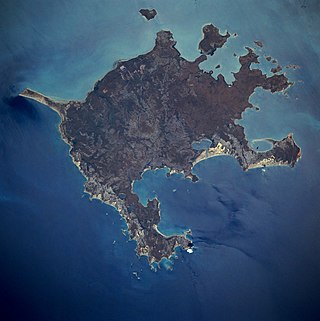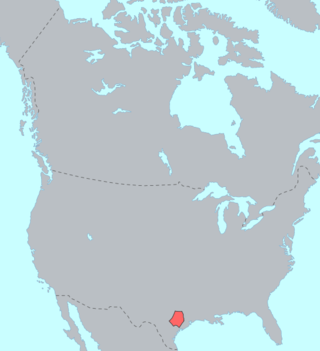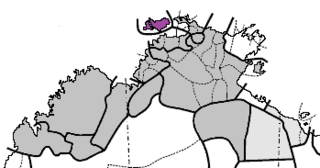
In linguistics, morphology is the study of words, how they are formed, and their relationship to other words in the same language. It analyzes the structure of words and parts of words such as stems, root words, prefixes, and suffixes. Morphology also looks at parts of speech, intonation and stress, and the ways context can change a word's pronunciation and meaning. Morphology differs from morphological typology, which is the classification of languages based on their use of words, and lexicology, which is the study of words and how they make up a language's vocabulary.

Groote Eylandt is the largest island in the Gulf of Carpentaria and the fourth largest island in Australia. It was named by the explorer Abel Tasman in 1644 and is Dutch for "Large Island" in archaic spelling. The modern Dutch spelling is Groot Eiland.

Madí—also known as Jamamadí after one of its dialects, and also Kapaná or Kanamanti (Canamanti)—is an Arawan language spoken by about 1,000 Jamamadi, Banawá, and Jarawara people scattered over Amazonas, Brazil.

The Tonkawa language was spoken in Oklahoma, Texas, and New Mexico by the Tonkawa people. A language isolate, with no known related languages, Tonkawa has not had L1 speakers since the mid 1900s. Most Tonkawa people now only speak English, but revitalization is underway.

Makassar people from the region of Sulawesi in Indonesia began visiting the coast of Northern Australia sometime around the middle of the 18th century, first in the Kimberley region, and some decades later in Arnhem Land. They were men who collected and processed trepang, a marine invertebrate prized for its culinary value generally and for its supposed medicinal properties in Chinese markets. The term Makassan is generally used to apply to all the trepangers who came to Australia.

Tiwi is an Australian Aboriginal language spoken by the Tiwi people on the Tiwi Islands, within sight of the coast of northern Australia. It is one of about 10% of Australian languages still being frequently learned by children.
Kanakanavu is a Southern Tsouic language spoken by the Kanakanavu people, an indigenous people of Taiwan. It is a Formosan language of the Austronesian family.
Murrinh-patha, called Garama by the Jaminjung, is an Australian Aboriginal language spoken by over 2,000 people, most of whom live in Wadeye in the Northern Territory, where it is the dominant language of the community. It is spoken by the Murrinh-Patha people, as well as several other peoples whose languages are extinct or nearly so, including the Mati Ke and Marri-Djabin. It is believed to be the most widely spoken Australian Aboriginal language not belonging to the Pama-Nyungan language family.
Angurugu is a community located on Groote Eylandt in the Northern Territory, Australia. The main spoken languages are Anindilyakwa, an Australian Aboriginal language, and English. Established as a Mission for the Church Mission Society, it is one of the three main indigenous settlements on the Groote Eylandt archipelago alongside Milyakburra and Umbakumba. According to the 2016 Census, the community had a population of 855, a decrease from 882 in 2006.

The East Arnhem Region is a local government area of the Northern Territory, Australia, governed by the East Arnhem Regional Council. Situated in the far north-eastern corner of the Northern Territory, the region covers an area of 33,310 square kilometres (12,861.06 sq mi) and had a population of approximately 10,345 in June 2018.
Gurindji is a Pama–Nyungan language spoken by the Gurindji and Ngarinyman people in the Northern Territory, Australia. The language of the Gurindji is highly endangered, with about 592 speakers remaining and only 175 of those speakers fully understanding the language. There are in addition about 60 speakers of Ngarinyman dialect. Gurindji Kriol is a mixed language that derives from the Gurindji language.
Marra, sometimes formerly spelt Mara, is an Australian Aboriginal language, traditionally spoken on an area of the Gulf of Carpentaria coast in the Northern Territory around the Roper, Towns and Limmen Bight Rivers. Marra is now an endangered language. The most recent survey was in 1991; at that time, there were only 15 speakers, all elderly. Most Marra people now speak Kriol as their main language. The remaining elderly Marra speakers live in the Aboriginal communities of Ngukurr, Numbulwar, Borroloola and Minyerri.
The Burarra language is an Australian Aboriginal language spoken by the Burarra people of Arnhem Land. It has several dialects.
Warndarrang (waɳʈaraŋ), also spelt Warndarang, Wanderang, Wandaran, and other variants is an extinct Aboriginal Australian language in the Arnhem family, formerly spoken by the Warndarrang people in southern Arnhem Land, along the Gulf of Carpentaria. The last speaker was Isaac Joshua, who died in 1974, while working with the linguist Jeffrey Heath.

Kaytetye is an Australian Aboriginal language spoken in the Northern Territory north of Alice Springs by the Kaytetye people, who live around Barrow Creek and Tennant Creek. It belongs to the Arandic subgroup of the Pama-Nyungan languages and is related to Alyawarra, which is one of the Upper Arrernte dialects. It has an unusual phonology and there are no known dialects.
Djaru (Tjaru) is a Pama–Nyungan language spoken in the south-eastern Kimberley region of Western Australia. As with most Pama-Nyungan languages, Djaru includes single, dual and plural pronoun numbers. Djaru also includes sign-language elements in its lexicon. Nouns in Djaru do not include gender classes, and apart from inflections, words are formed through roots, compounding or reduplication. Word order in Djaru is relatively free and has the ability to split up noun phrases. The Djaru language has a relatively small number of verbs, as compared to most languages, and thus utilizes a system of 'preverbs' and complex verbs to compensate. Djaru also has an avoidance language. Avoidance languages, sometimes known as 'mother-in-law languages', are special registers within a language that are spoken between certain family members – such registers are common throughout native Australian languages.

The Anindilyakwa people (Warnumamalya) are Aboriginal Australian people living on Groote Eylandt, Bickerton Island, and Woodah Island in the Gulf of Carpentaria in the Northern Territory of Australia.
The Nunggubuyu are an Aboriginal Australian people of eastern Arnhem Land in the Northern Territory.

Wurrwurrwuy stone arrangements is a heritage-listed indigenous site at Yirrkala, Northern Territory, Australia. It is also known as Wurrwurrwuy. It was added to the Northern Territory Heritage Register on 15 August 2007 and to the Australian National Heritage List on 9 August 2013.
Umbakumba is a community located on Groote Eylandt in the Gulf of Carpentaria, Northern Territory, Australia. The main spoken languages are Anindilyakwa, an Australian Aboriginal language, and English. There are also several Yolŋu Matha speakers. It is one of the three main settlements on the Groote Eylandt archipelago, including Milyakburra and Angurugu, where Anindilyakwa is the predominant spoken language. According to the 2016 Australian Census, the population of Umbakumba was 503, an increase from 441 in 2011.











